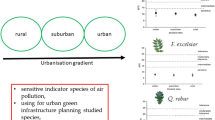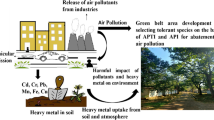Abstract
Air pollution is a regional issue in Asia. To assess air pollution levels and their actual impacts on plants, environmental monitoring using indicator plants has been conducted since the 1970s. In particular, in Japan, during the 1970s/1980s when air pollution levels were relatively high, various kinds of indicator plants were used for monitoring air pollution. Some vascular plants, such as morning glory and petunia, were used as indicator plants for monitoring the pollution of photochemical oxidants (Ox), including O3 and peroxyacetyl nitrate (PAN). In the middle of the 1970s, nationwide surveys using morning glory revealed Ox pollution in 37 of the 47 prefectures in Japan. Epiphytes, such as bryophytes and lichens, were used as bio-indicators for SO2 pollution. The “epiphyte desert” observed in urban and industrial areas showed severe SO2 pollution in large cities in Japan during the 1970s. An improvement in the distribution of epiphytes resulted in reduced SO2 pollution in Japan during the 1980s. Similar environmental monitoring using bryophytes and lichens as bio-indicators was conducted in other Asian countries. Common tree species, such as cedar, can also be used as indicator plants for environmental monitoring. Further application of such monitoring in Asian countries should be promoted.
Access this chapter
Tax calculation will be finalised at checkout
Purchases are for personal use only
Similar content being viewed by others
References
Ahn et al (2011) Epiphytic macrolichens in Seoul: 35 years after the first lichen study in Korea. J Ecol Field Biol 34:381–391
De Sloover J, LeBlanc F (1968) Map** of atmospheric pollution on the basis of lichen sensitivity. In: Misra R, Gopal B (eds) Proceeding of the symposium on recent advances in tropical ecology. Banaras Hindu University, Varanasi, pp 42–56
Giordani P et al (2014) Detecting the nitrogen critical loads on European forests by means of epiphytic lichens. A signal-to-noise evaluation. For Ecol Manag 311:29–40
Hatta H, Terakado K (1975) Effect of photochemical oxidant on morning glory and its validity as indicator plant, I. Characteristics of oxidant damage on morning glory and correlation between leaf damage index and oxidant dose. J Jpn Soc Air Pollut 9:722–728 (in Japanese with English summary)
Ishibashi R et al (1982) Heavy metal determination of epiphytic mosses as an attempt to indicate industrial pollution of environment. J Jpn Soc Air Pollut 17:63–69 (in Japanese with English summary)
Ishida T et al (2015) Characterization of sulfur deposition over the period of industrialization in Japan using sulfur isotope ratio in Japanese cedar tree rings taken from stumps. Environ Monit Assess 187:459
Izuta T et al. (1988) An evaluation of atmospheric environment by a plant indicator based on the growth of radish plants grown in small open-top chambers. J Jpn Soc Air Pollut 23:284–292 (in Japanese with English summary)
Katoh T et al (1988a) An assessment of effects of air pollution on the ring width of Japanese cedars (Cryptomeria japonica D. Don) (I) –relationships between the operation of thermoelectric power stations and fluctuations of the standardized ring index. J Jpn Soc Air Pollut 23:311–319 (in Japanese with English summary)
Katoh T et al (1988b) An assessment of effects of air pollution on the ring width of Japanese cedars (Cryptomeria japonica D. Don) (II) –relationships between the standardized ring index and the pollution levels of SO2 and NO2 in the ambient air at the surrounding area of thermoelectric power stations. J Jpn Soc Air Pollut 23:320–328 (in Japanese with English summary)
Kawamura H et al (2006) Isotopic evidence in tree rings for historical changes in atmospheric sulfur sources. Environ Sci Technol 40:5750–5754
Kobayashi T, Nakagawa Y (1986) Estimation of atmospheric mercury pollution by using epiphytic lichen. J Jpn Soc Air Pollut 21:151–155 (in Japanese with English summary)
Kobayashi T, Nakagawa Y (1990) Estimation of atmospheric mercury pollution by using epiphytic lichens. –Map** the distribution of mercury content in Parmelia tinctorum over the Hyogo Prefecture. J Jpn Soc Air Pollut 25:206–211 (in Japanese with English summary)
Kuang YW et al (2007) Heavy metals in bark of Pinus massoniana (Lamb.) as an indicator of atmospheric deposition near a smeltery at Qujiang, China. Environ Sci Pollut Res 14:270–275
Kuno H, Ohashi (1993a) Indicator plants for air pollution (1). J Jpn Soc Air Pollut 28:A45–A52 (in Japanese)
Kuno H, Ohashi (1993b) Indicator plants for air pollution (2). J Jpn Soc Air Pollut 28:A65–A76 (in Japanese)
Liu XY et al (2008) Tissue N content and 15N natural abundance in epilithic mosses for indicating atmospheric N deposition in the Guiyang area, SW China. Appl Geochem 23:2708–2715
Liu XY et al (2009) Assessment of atmospheric sulfur with the epilithic moss Haplocladium microphyllum: evidences from tissue sulfur and δ34S analysis. Environ Pollut 157:2066–2071
Liu XY et al (2010) Response of stable carbon isotope in epilithic mosses to atmospheric nitrogen deposition. Environ Pollut 158:2273–2281
Lu Z et al (2011) Sulfur dioxide and primary carbonaceous aerosol emissions in China and India, 1996–2010. Atmos Chem Phys 11:9839–9864
Mitsugi H (1994) Map** of environmental aspect based on epiphytic bryophyte vegetation in Hyogo Prefecture. Environ Sci 7:313–323 (in Japanese with English summary)
Mitsugi et al (1978) Epiphytic bryophytes and lichens as the indicator of air pollution, -correlation between some air pollutants and IAP values. J Jpn Soc Air Pollut 13:26–32 (in Japanese with English summary)
Nakagawa Y, Kobayashi T (1990) Estimation of air pollution based on the distribution and the component of epiphytic lichens by means of the modified IAP method. J Jpn Soc Air Pollut 25:233–241 (in Japanese with English summary)
Nogami et al (1987) An evaluation of the air pollution by using heavy metals accumulation in Bryum argenteum Hedw. J Jpn Soc Air Pollut 22:347–354 (in Japanese with English summary)
Nouchi I, Aoki K (1979) Morning glory as a photochemical oxidant indicator. Environ Pollut 18:289–303, 1970
Nouchi I et al (1984) Atmospheric PAN concentrations and foliar injury to petunia indicator plants in Tokyo. J Jpn Soc Air Pollut 19:392–402, in Japanese with English summary
Ohara T et al (2007) An Asian emission inventory of anthropogenic emission sources for the period 1980–2020. Atmos Chem Phys 7:4419–4444
Ohmura Y et al (2008) Long-term monitoring of Parmotrema tinctorum and qualitative changes of air pollution in Shimizu Ward, Shizuoka City, Japan. J Jpn Soc Atmos Environ 43:47–54 (in Japanese with English summary)
Omura M, Murata A (1984) Epiphytic lichen and bryophyte vegetation as a bioindicator of air pollution, – the recent transition in industrial areas of Fukuoka Prefecture. J Jpn Soc Air Pollut 19:462–472 (in Japanese with English summary)
Saipunkaew et al (2007) Epiphytic macrolichens as indicators of environmental alteration in Northern Thailand. Environ Pollut 146:366–374
Sase H et al (1998a) Variation in amount and elemental composition of epicuticular wax in Japanese cedar (Cryptomeria japonica) leaves associated with natural environmental factors. Can J For Res 28:87–97
Sase H et al (1998b) Changes in properties of epicuticular wax and the related water loss in Japanese cedar (Cryptomeria japonica) affected by anthropogenic environmental factors. Can J For Res 28:546–556
Satake K et al (1996) Accumulation of lead in tree trunk bark pockets as pollution time capsules. Sci Total Environ 181:25–30
Shimizu H et al (1988) Studies on the evaluation of atmospheric quality by bryophytes -development and characteristics of a method using twin chambers. Proc Bryol Soc Jpn 4:155–161
Smith SJ et al (2011) Anthropogenic sulfur dioxide emissions: 1850–2005. Atmos Chem Phys 11:1101–1116
Sugiyama K et al (1976) Studies on lichens as a bioindicator of air pollution. I. Correlation of distribution of Parmelia tinctorum with SO2 air pollution. Jpn J Ecol 26:209–212
Takamatsu T et al (2000) Aerosol elements on tree leaves – antimony as a possible indicator of air pollution. Global Environ Res 4:49–60
Taoda H (1972) Map** of atmospheric pollution in Tokyo based upon epiphytic bryophytes. Jpn J Ecol 22:125–133
Taoda H (1973) Bryo-meter, an instrument for measuring the phytotoxic air pollution. HIKOBIA 6:224–228
Taoda H (1996) Tolerance of some epiphytic bryophytes to simulated acid rain. Proc Bryol Soc Jpn 6:237–243
Thrower (1980) Air pollution and lichens in Hong Kong. Lichenologist 12:305–311
Umezu Y (1978) Map** of air pollution intensity by epiphytic bryophyte and lichen communities in heavy industry region. Jpn J Ecol 28:143–154 (in Japanese with English summary and German captions)
Wakamatsu et al (2013) Air pollution trends in Japan between 1970 and 2012 and impact of urban air pollution countermeasures. Asian J Atmos Environ 7:177–190
Yokobori (1978) Measuring of phytotoxic air pollution based upon response of bryophytes using a filtered-air growth chamber. Jpn J Ecol 28:17–23 (in Japanese with English summary)
Author information
Authors and Affiliations
Corresponding author
Editor information
Editors and Affiliations
Rights and permissions
Copyright information
© 2017 Springer Japan
About this chapter
Cite this chapter
Sase, H. (2017). Environmental Monitoring with Indicator Plants for Air Pollutants in Asia. In: Izuta, T. (eds) Air Pollution Impacts on Plants in East Asia. Springer, Tokyo. https://doi.org/10.1007/978-4-431-56438-6_7
Download citation
DOI: https://doi.org/10.1007/978-4-431-56438-6_7
Published:
Publisher Name: Springer, Tokyo
Print ISBN: 978-4-431-56436-2
Online ISBN: 978-4-431-56438-6
eBook Packages: Earth and Environmental ScienceEarth and Environmental Science (R0)




